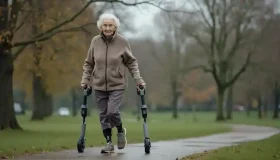Are you worried about the effects of aging on your health and vitality? A groundbreaking clinical trial is changing how we view getting older. This study shows that 70 could become the new 50, thanks to innovative age-reversal techniques.
You’ll learn about the key discoveries and benefits of this research that could help you feel younger and healthier. Get ready to explore the future of aging.
Key Takeaways
- Scientists found six chemical mixes that can reverse cell aging in less than a week, targeting protein movement in cells.
- A clinical trial showed telomeres growing 200% longer in participants, potentially leading to longer, healthier lives.
- A drug targeting stem cells could improve physical function in older adults by lengthening telomeres, with human trials for osteoarthritis set to begin in 2025.
- Researchers are working on safely removing senescent cells from the body to slow aging and prevent age-related diseases.
- Telomir Pharmaceuticals is leading a study on dogs that could lead to human trials, with results expected in early 2025.
Key Discoveries from the Clinical Trial

The clinical trial revealed groundbreaking methods to reverse cellular aging. Scientists found ways to improve longevity markers in participants, opening new doors for age-reversal research.
Chemical methods to reverse cellular aging
Scientists have found new ways to make cells younger. A team from Harvard, MIT, and the University of Maine discovered six chemical mixes that can turn back the clock on aging cells.
These mixes work fast, making old cells act young again in less than a week. This breakthrough could change how we treat age-related health issues.
You might wonder how these chemicals work. They target specific parts of cells that change as we age. One key area is how proteins move around inside cells. As we get older, this movement slows down.
But these new chemical methods can restore the quick, youthful movement of proteins. This could lead to better health and fewer age-related problems for seniors like you.
Improved longevity markers in participants
You’ll be excited to hear about the amazing results from recent age-reversal studies. Participants showed big improvements in key longevity markers. Their telomeres, the protective caps on DNA, grew 200% longer.
This is a huge deal because longer telomeres often mean a longer, healthier life.
But that’s not all. The trials also showed great promise for treating age-related diseases. Senior dogs with serious health problems got much better. Some even beat terminal cancer and severe arthritis.
These findings give hope that similar treatments could work for humans too. They suggest we might soon be able to turn back the clock on aging and live healthier lives well into our later years.
Benefits of the Age-Reversal Clinical Trial
The age-reversal clinical trial shows promise for seniors. You might see better physical function and fewer age-related health issues.
Enhanced physical function in older adults
You might soon enjoy better physical function as you age. New research shows promise in boosting your body’s health and strength. A drug that targets stem cells could make this possible.
It works by lengthening telomeres, which are linked to cell health. This means your body could stay stronger and more active for longer.
Studies have shown great results in early tests. The drug increased telomere length by a lot. This could lead to improved mobility and less age-related decline. Human trials are coming up next.
They’ll focus on helping people with osteoarthritis move better. If successful, you might find yourself feeling younger and more able-bodied as you get older. Let’s look at how this breakthrough could affect age-related diseases.
Reduction in age-related diseases
Age reversal treatments show promise in fighting diseases that come with getting older. A new clinical trial targets stem cells to combat cellular aging. This approach aims to lengthen telomeres, which may help reduce age-related illnesses.
The trial’s success could mean fewer cases of heart disease, diabetes, and other conditions that often affect seniors.
Researchers are also looking into ways to safely remove senescent cells from the body. These cells can harm your health as you age. By getting rid of them, scientists hope to slow down the aging process and prevent many age-related problems.
The goal is to help you stay healthier and more active as you grow older. Human trials for osteoarthritis treatment are set to begin in 2025, offering hope for improved joint health in seniors.
Future Implications of the Trial
The age-reversal trial opens doors to new medical treatments. Scientists plan to test these methods on a larger scale soon.
Potential for widespread clinical application
Age-reversal breakthroughs show promise for widespread use in humans. Telomir Pharmaceuticals leads a study on dogs that could pave the way for human trials. This research aims to turn back the clock on aging, potentially making 70 feel like 50.
Scientists expect to review results from the current canine study in early 2025.
Exciting developments in cellular rejuvenation offer hope for treating age-related diseases. Harvard and MIT researchers have found a chemical method to reverse cell aging without gene therapy.
This approach could lead to new treatments for conditions like Alzheimer’s and diabetes. Japanese scientists have also made strides in understanding aging mechanisms, focusing on removing old, damaged cells to improve health.
Next steps in research and development
Researchers are gearing up for exciting new steps in age-reversal science. Human clinical trials for osteoarthritis will start in mid-2025. Dr. Christopher Chapman and Dr. Michael Roizen lead a study testing a drug to lengthen telomeres on stem cells.
This drug showed promise in lab tests, increasing telomere length by 200% in human cells.
Scientists have found six chemical mixes that can make cells young again. These mixes fix protein sorting in cells, making them work like they did when you were younger. Japanese experts have also found a drug that removes old, harmful cells without hurting healthy ones.
While waiting for these new treatments, you can help yourself by fasting now and then, and spending time with friends and family.
Conclusion
The age-reversal breakthrough brings hope for a healthier, more active future. You might soon see 70-year-olds with the vitality of 50-year-olds. This research opens doors to better treatments for age-related diseases like Alzheimer’s and arthritis.
As studies progress, you could benefit from these advances in the coming years. The potential for a longer, more vibrant life is within reach, thanks to this groundbreaking work in regenerative medicine.
FAQs
1. What is the age-reversal breakthrough clinical trial about?
The trial explores using induced pluripotent stem cells and Yamanaka factors to achieve whole-body rejuvenation. It aims to reverse aging signs and make 70 feel like 50.
2. How do scientists measure aging in this study?
Researchers use transcription-based aging clocks and the nucleocytoplasmic protein compartmentalization assay to track changes in transcriptomic age and cell function.
3. What health issues might this research address?
This work could help with hardening of the arteries, Alzheimer’s disease, and diabetic complications. It may also improve kidney function and reduce inflammation.
4. Are there risks involved in age-reversal treatments?
Yes, potential risks include uncontrolled cell growth leading to cancer. Scientists must carefully balance rejuvenation with safety in their studies.
5. How might this research affect lifespan?
While not directly extending life span, this work aims to improve health in later years. It could reduce age-related diseases and enhance quality of life.
6. What role do genes play in this age-reversal process?
Genes are key in this process. The treatment aims to reset genetic expression patterns to a younger state, potentially repairing DNA damage and reducing inflammation.
Source URLs





